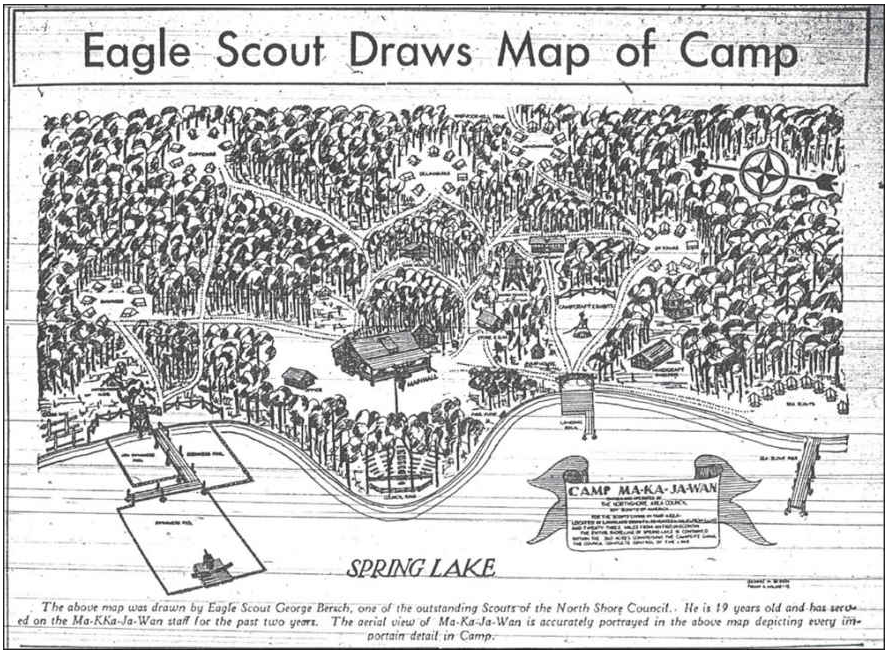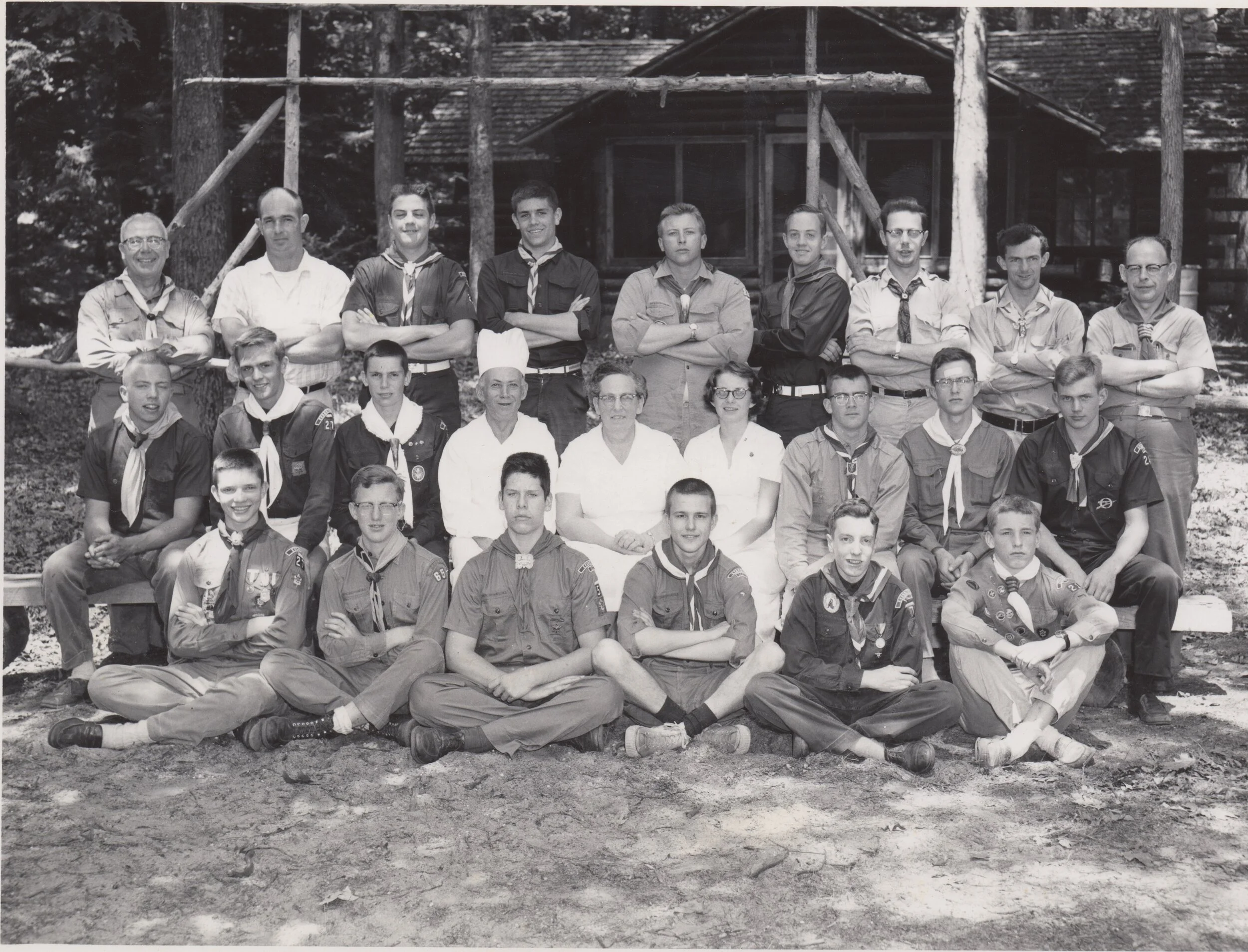History of Ma-Ka-Ja-Wan Scout Reservation
Camp Ma-Ka-Ja-Wan is in many ways sacred to the Northeast Illinois Council. It has provided countless young people, adult leaders, and their families with an opportunity to enjoy the Northwoods of Wisconsin. Youth who journey to Ma-Ka-Ja-Wan learn Scout skills, develop leadership abilities, grow as individuals, and establish long-lasting friendships.
Introduction
The founders of Camp Ma-Ka-Ja-Wan had a vision of finding a location for a summer camp for the young people of the North Shore Area Council, BSA. The first Scout Executive, Walter MacPeek, was assigned the task of locating a site. MacPeek spent 10 days searching around Rhinelander, Wisconsin. Failing to find what he wanted, a chance meeting at the Elcho Inn with a Winnetka resident who had a interest in the Thunder Lake Lumber Co. brought the suggestion of land near Pearson, Wisconsin, as a site.
With major gifts from General Wood and Albert P. Snite, the purchase from Walter J. Hammond and the C.W. Fish Lumber Company was made possible. The foresight of these men led to buying the land surrounding the lake, so the original 240 acres of present East Camp at Ma-Ka-Ja-Wan was increased to 450 acres within a few years. The founders’ dream of purchasing their own summer camp was fulfilled on July 26, 1928. The location was exactly what they were looking for and more.
A map drawn by an Eagle Scout from the North Shore Area Council depicting the original property of then Camp Ma-Ka-Ja-Wan.
An early photo of the East Camp Dining Lodge
East Camp
East Camp comprises the “original” land of Ma-Ka-Ja-Wan Scout Reservation, and thus has all the atmosphere and rich tradition of one of the oldest scout camps in the nation. In 1929, the North Shore Area Council’s Camping Committee decided to erect numerous building to prepare for the grand opening of the camp in the summer of 1929. Among the structures built were a dining hall, camp office, waterfront boathouse, icehouse, and many other buildings. Campsites were cleared out close to the camp office and dining hall. At the time, the campsites had no running water and used simple latrines and washstands.
The scouts who attended Ma-Ka-Ja-Wan in the early years would take a train to Elcho, Wisconsin, from Highland Park, Illinois. After arriving in Elcho, they would be transported to the west side of Spring Lake—later unofficially renamed Lake Killian—and unload their gear into a US Navy barge to be ferried across to the eastern bank.
The aquatics area is still situated on the sandy beach as it was back then, and other features are unchanged by time. In the 1970s, many updates were made to accommodate more campers. Some sights not to be missed in East Camp include the original Order of the Arrow Lodge, the birch bark canoe hanging in the dining hall, and the majestic view of Lake Killian from the fire bowl.
West Camp
Following World War II, Ma-Ka-Ja-Wan Scout Reservation began a long period of growth. Expansion of the current camp was not enough to keep pace with the scouts journeying to the Northwoods to experience the magic of Ma-Ka-Ja-Wan. Under the leadership of Scout Executive Edwin A. Schwechel, the North Shore Area Council began the process of adding a second camp to the West shore of Lake Killian.
Buying additional property from farmer and staff member Burnam Skidmore, the council began building the needed facilities to double Ma-Ka-Ja-Wan’s capacity and facilities. After two years of planning and building, West Camp opened in June 1959. Through the years, both camps have continued to expand. In recent history, West Camp has seen improvements to its Ecology Lodge, Field Archery, and the addition of the new program areas Pinnacle & Trailblazer. Troops and Staff still line up twice a day circling the Flagpole in the giant field for morning and evening flag.
Camp Ma-Ka-Ja-Wan West Camp Staff from 1959
Wabaningo Staff, 1950s
Wabaningo
Wabaningo was added to Ma-Ka-Ja-Wan Scout Reservation as a result of one of the mergers that created the present Northeast Illinois Council. The Evanston Council owned and operated Camp Wabaningo on Duck Lake in Western Michigan after it acquired the property in 1920. After the Evanston Council merged with the North Shore Area Council in 1969, the merged council operated Camp Wabaningo through the 1970 season, after which it was sold.
The proceeds from the sale were used to buy the land west of County Highway T. The property included a lake, renamed Lake Bannard in honor of longtime Northfield Scouter Hib Bannard, farm buildings, now named Triangle M Horse Ranch, and undeveloped woods and fields. The new land was named Wabaningo in honor of the previous camp.
learn more
IMAGES OF AMERICA: CAMP MA-KA-JA-WAN
Written by former staff members Matt Horbal and Ian Hopkins, this is a great read about the history of Ma-Ka-Ja-Wan. Copies are available at our camp store or you can buy it here on Amazon.
MA-KA-JA-WAN LODGE #40: THE FIRST 90 YEARS
Written by John L. Ropiequet and Ian Hopkins, this book provides an overview of the history of Ma-Ka-Ja-Wan’s OA Lodge. This can be purchased at the camp store, council office, or online here on the OA Trading Post.






